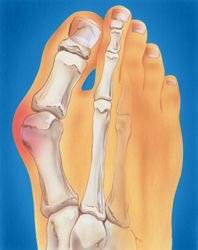Bunions
What are bunions?
|
The common bunion is a localized area of enlargement of the inner portion of the joint at the base of the big toe. The enlargement actually represents additional bone formation, often in combination with a misalignment of the big toe. The misalignment causes the big toe to move outward (medically termed hallux valgus deformity). The normal position of the big toe (straight forward) becomes outward directed toward the smaller toes. The enlarged joint at the base of the big toe (the first metatarsophalangeal joint, or MTP joint) can become inflamed with redness, tenderness, and pain. A small fluid-filled sac (bursa) adjacent to the joint can also become inflamed (bursitis), leading to additional swelling, redness, and pain. A less common bunion is located at the joint at the base of the smallest (fifth) toe. This bunion is sometimes referred to as a tailor’s bunion. |
Who develops bunions?
Bunions most commonly affect women. Some studies report that bunions occur nearly 10 times more frequently in women. It has been suggested that tight-fitting shoes, especially high-heel and narrow-toed shoes, might increase the risk for bunion formation. Bunions are reported to be more prevalent in people who wear shoes than in barefoot people. While the precise causes are not known, there also seems to be inherited (genetic) factors that predispose to the development of bunions, especially when they occur in younger individuals.
Other risk factors for the development of bunions include abnormal formation of the bones of the foot at birth (congenital), nerve conditions that affect the foot, rheumatoid arthritis, and injury to the foot. Bunions are common in ballet dancers.
What are symptoms and signs of a bunion?
Bunions may or may not cause symptoms. A frequent symptom is foot pain in the involved area when walking or wearing shoes that is relieved by resting. A bunion causes enlargement of the base of the big toe and is usually associated with positioning of the big toe toward the smaller toes. This leads to intermittent or chronic pain at the base of the big toe.
Bunions that cause marked pain are often associated with swelling of the soft tissues, redness, and local tenderness. It is important to note that, in post-pubertal men and post-menopausal women, pain at the base of the big toe can be caused by gout and gouty arthritis that is similar to the pain caused by bunions.
Definition: The medical terms used to describe a bunion are Hallux Valgus and Hallux Abducto Valgus.
Bunions are a progressive deformity, and if left untreated the bump will become larger, and the big toe will eventually lie over or under the second toe.
Causes
The normal foot is made up of bones and joints, which are held tightly together, in a precise relationship. In order for a bunion to form, the ligaments and tendons which hold the bones and joints together must be more flexible than normal. This abnormal flexibility is usually the result of a biomechanical foot defect called pronation, which destroys the normal relationship between the big toe and the first metatarsal. Pronation is caused by either the genes we inherit, or the way our feet lie against the uterine wall prior to our birth. Pronation is a turning outward of the foot at the ankle, so that one has a tendency to walk on the inner border of the foot. When this occurs, we walk with an abnormal amount of our weight being forced on the big toe and first metatarsal. The result is a bump on the inner side of the foot, and a big toe which is pushed over toward the second toe. When flat feet occur along with pronation, the foot becomes even more flexible and susceptible to bunion formation.
Bunion progression may be hastened by:
-
Wearing high heel and pointed toe shoes. These types of shoes apply abnormal pressure to the big toe and force it over toward the second toe; they also irritate the first metatarsal head causing a bump to form (when bone is irritated it enlarges).
-
An injury to the inner side of the foot or big toe may damage the first metatarsalphalangeal joint, and speed up bunion formation.
-
Arthritis of the first metatarsalphalangeal joint may cause the joint to become enlarged, and a bunion may then form.
-
Some neurological diseases cause contractures of the joints of the feet and toes, helping bunions to form.
Treatment
Long-term treatment of bunions must be directed towards re-balancing the foot, so that we no longer walk with our weight forced on to the inner border of the foot. This is accomplished by controlling and reducing pronation with the use of a high quality arch support or custom made orthotics. These devices comfortably re-balance the feet and overcome pronation. This reduces the abnormal weight forces on the big toe and its metatarsal head, allowing the feet to function normally. As a result, the deformity should not worsen, and the pain should gradually subside. If the foot is not re-balanced, the deformity and pain will become worse. For more information about our custom-made orthotics for bunions, which will fit in any shoe with a heel height of 1 1/2″ inches or less, click here.
